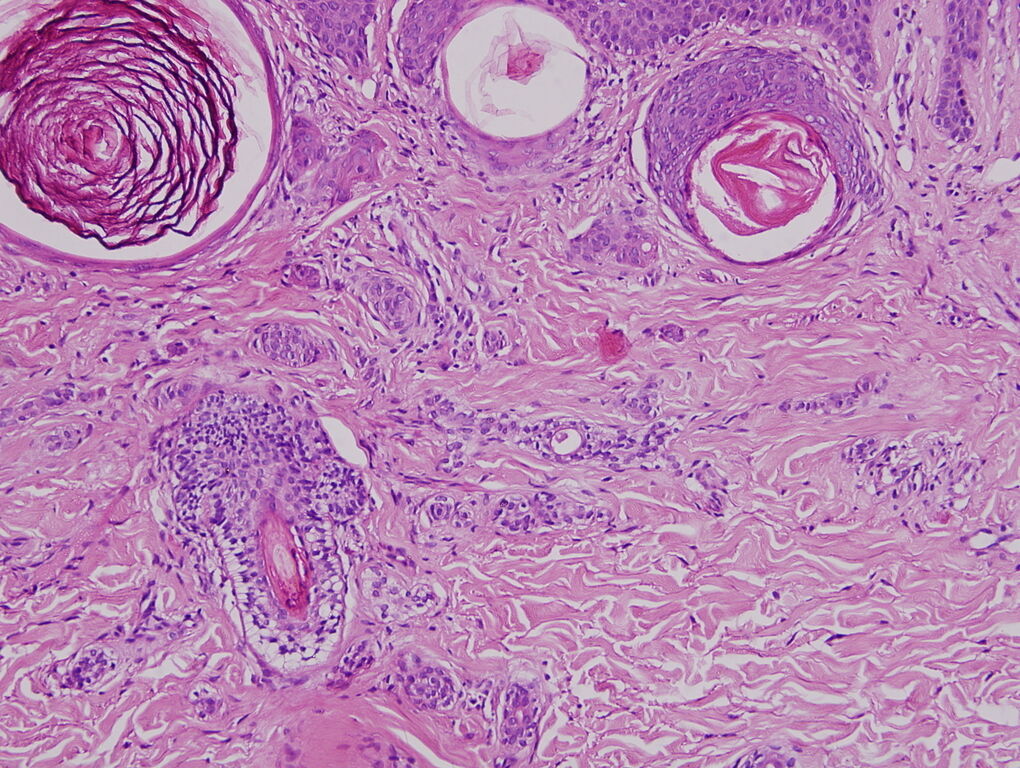A Possible New Variants of Familial Syringoma: Case Reports and Review of Literature
Keywords:
Familial eruptive syringoma, adnexal tumor, tadpole, eccrine sweat duct, botulinum toxinAbstract
Syringoma is a benign tumor of the intraepidermal portion of eccrine sweat ducts with distinct histopathology features, including the characteristic comma (tadpole)-shaped tail comprised of dilated, cystic eccrine ducts. Syringoma was classified into four main clinical variants: localized, familial, a variant associated with Down syndrome, and a generalized form with multiple and eruptive syringoma.
In familial eruptive syringoma is a rare form of syringoma. The clinical presentations are firm, smooth, skin-colored to pigmented, discrete papules that appear as successive crops on the anterior body surface of individuals who also have one or more family members with similar eruptive or localized lesions. Treatment of these benign conditions is a cosmetic purpose by destructive methods, medical therapies or a new treatment modality such as botulinum toxin A.
This report presents two cases of familial eruptive syringoma at the Institute of Dermatology in Thailand and literature reviews of familial eruptive syringoma: The first case, a 15-year-old Thai female presented with eruptive syringoma on the left lower eyelid, neck, antecubital fossae, groins, and mon pubis and her mother also had syringoma on the lower eyelids. In the second case, a 15-year-old Thai female presented with eruptive syringoma on the face, trunk, back, and extremities, as well as her father and uncle.
References
Timothy H, Laura B. Adnexal Neoplasm. In: Bolognia JL, Schaffer JV, Cerroni L, et al. editors. Bolognia Dermatology. 4th ed. Edinburgh: Elsevier; 2018:1944-5.
Lau J, Haber RM. Familial eruptive syringomas: case report and review of the literature. J Cutan Med Surg 2013;17:84-8.
Singh S, Tewari R, Gupta S. An unusual case of generalised eruptive syringoma in an adult male. Med J Armed Forces India 2014;70:389-91.
Friedman SJ, Butler DF. Syringoma presenting as milia. J Am Acad Dermatol 1987;16:310-4.
Jacquet L, Darier J. Hiydradénomes éruptifs, épithéliomes adénoides des glandes sudoripares ou adénomes sudoripares. Ann Dermatol Syph 1887;8:317–23.
Wu WM, Lee YS. Autosomal dominant multiple syringomas linked to chromosome 16q22. Br J Dermatol 2010;162:1083-7.
Uede K, Yamamoto Y, Furukawa F. BrookeeSpiegler syndrome associated with cylindroma, trichoepithelioma, spiradenoma and syringoma J Dermatol 2004;31:32-8.
Dupré A, Carrère S, Bonafé JL, Christol B, Lassère J, Touron P. Syringomes éruptifs généralisés, grains de milium et atrophodermie vermiculée. Syndrome de Nicolau et Balus [Eruptive generalized syringomas, milium and atrophoderma vermiculata. Nicolau and Balus' syndrome (author's transl)]. Dermatologica 1981;162:281-6.
Nguyen V, Buka R, Roberts BJ, Eichenfield LF. Cutaneous manifestations of Costello syndrome. Int J Dermatol 2007;46:72-6.
Yesudian P, Thambiah A. Familial syringoma. Dermatologica 1975;150:32-5.
Hashimoto K, Blum D, Fukaya T, Eto H. Familial syringoma. Case history and application of monoclonal anti-eccrine gland antibodies. Arch Dermatol 1985;121:756–60.
Ribera M, Servitje O, Peyri J, Ferrándiz C. Familial syringoma clinically suggesting milia. J Am Acad Dermatol 1989;20:702-3.
Patrizi A, Neri I, Marzaduri S, Varotti E, Passarini B. Syringoma: a review of twenty-nine cases. Acta Derm Venereol 1998;78:460-2.
Metze D, Wigbels B, Hildebrand A. Familial syringoma: a rare clinical variant. Hautarzt 2001;52:1045-8.
Smith KJ, Skelton HG. Familial syringomas: an example of gonadal mosaicism. Cutis 2001;68:293-5.
Soler-Carrillo J, Estrach T, Mascaró JM. Eruptive syringoma: 27 new cases and review of the literature. J Eur Acad Dermatol Venereol 2001;15:242–6.
Bautista ST, Orrego GV, Salas MLT. Siringoma eruptivo familiar. Dermatol Peruana 2003;13:227-30.
Elsayed M, Assaf M. Familial eruptive syringoma. Egyptian Dermatology Online Journal 2009;5:1-6.
Marzano AV, Fiorani R, Girgenti V, Crosti C, Alessi E. Familial syringoma: report of two cases with a published work review and the unique association with steatocystoma multiplex. J Dermatol 2009;36:154–8.
Lau J, Haber RM. Famililal eruptive syringomas: case report and review of the literature. J Cutan Med Surg 2013;17:84-8.
Singh SK, Rai T. Familial syringomas. Indian J Dermatol 2013;58:412.
Ibekwe P. Familial eruptive syringoma in a Nigerian girl. Clin Exp Dermatol 2016;41:383-5.
Yaldiz M, Cosansu C, Erdem MT, Dikicier BS, Kahyaoglu Z. Familial eruptive syringoma. Hong Kong Med J 2018;24:200-2.
Mahaisaviriya P, Techapichetvanich T. Familial Eruptive Syringoma in a Thai Women: Case Report and Literature Review. Thai J Dermatol 2020;36:7-14.
Williams K, Shinkai K. Evaluation and management of the patient with multiple syringomas: A systematic review of the literature. J Am Acad Dermatol 2016;74:1234-40.
Zaldivar-Fujigaki JL, Achell Nava L. Botulinum toxin A as monotherapy for syringoma. J Cosmet Dermatol 2021;20:1393-5.

Downloads
Published
How to Cite
Issue
Section
License
Copyright (c) 2022 Thai Journal of Dermatology

This work is licensed under a Creative Commons Attribution-NonCommercial-NoDerivatives 4.0 International License.
เนื้อหาและข้อมูลในบทความที่ลงตีพิมพ์ในวารสารโรคผิวหนัง ถือเป็นข้อคิดเห็นและความรับผิดชอบของผู้เขียนบทความโดยตรงซึ่งกองบรรณาธิการวารสาร ไม่จำเป็นต้องเห็นด้วย หรือร่วมรับผิดชอบใดๆ
บทความ ข้อมูล เนื้อหา รูปภาพ ฯลฯ ที่ได้รับการตีพิมพ์ในวารสารโรคผิวหนัง ถือเป็นลิขสิทธิ์ของวารสารฯ หากบุคคลหรือหน่วยงานใดต้องการนำทั้งหมดหรือส่วนหนึ่งส่วนใดไปเผยแพร่ต่อหรือเพื่อกระทำการใดๆ จะต้องได้รับอนุญาตเป็นลายลักอักษรจากบรรณาธิการวารสารโรคผิวหนังก่อนเท่านั้น


